
Before we begin, I'd like to take a moment to discuss my friend the microwave. As you'll notice, it is my cooking instrument of choice. It's fast, times itself, and doesn't make me afraid I'm going to burn myself or my house down.
Unfortunately, it seems a lot of people don't share my love for the microwave (or my unreasonable fear of the stove). The suspicions that originally surrounded this technologically advanced appliance are understandable, but it's been a long time since 1967. Let's address these fears and move on, shall we?
Radiation: Radiation means waves of energy. It's how atomic bombs work, and it’s how your microwave works. However, unlike an atomic bomb, the smaller gentler waves emitted by a microwave are trapped and reflected around the oven by its metal walls. That's how the waves heat your food. Once the timer dings, the waves stop being generated. The radiation doesn't stay in the microwave, and it doesn't stay in your food. There is probably more radioactive material in your grandmother’s antique dishes than what's coming out of your microwave.
Unfortunately, it seems a lot of people don't share my love for the microwave (or my unreasonable fear of the stove). The suspicions that originally surrounded this technologically advanced appliance are understandable, but it's been a long time since 1967. Let's address these fears and move on, shall we?
Radiation: Radiation means waves of energy. It's how atomic bombs work, and it’s how your microwave works. However, unlike an atomic bomb, the smaller gentler waves emitted by a microwave are trapped and reflected around the oven by its metal walls. That's how the waves heat your food. Once the timer dings, the waves stop being generated. The radiation doesn't stay in the microwave, and it doesn't stay in your food. There is probably more radioactive material in your grandmother’s antique dishes than what's coming out of your microwave.
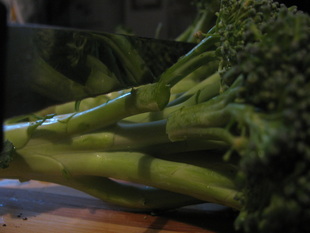
Nutrient depletion: Any heating of food causes damage to nutrients. It's all about how long, how hot and how much water you use. If you read articles slamming microwaves, you'll probably hear about a study done on broccoli where flavonoids (a water-soluble compound that fights cancer) were reduced 97%. What they don't tell you is that that the study's water use and cooking times were excessive, and that in many cases the microwave is better than boiling and pressure cooking for nutrient retention (though there are ways to bring these methods up to snuff. Steaming is apparently the best way to keep the nutrients in vegetables). This brings us to today's cooking expedition...
The plan:
Broccoli has been touted as a super food for its skin-repairing, immune system-boosting, bone-building properties, and that's just the short list. When steamed, a cup (150 g) of broccoli provides all the vitamin C and K you need in a day. It's also a great source of vitamin A, heart and baby friendly folate, and dietary fibre. Plus, a cup of broccoli only costs you 45 calories.
The plan:
Broccoli has been touted as a super food for its skin-repairing, immune system-boosting, bone-building properties, and that's just the short list. When steamed, a cup (150 g) of broccoli provides all the vitamin C and K you need in a day. It's also a great source of vitamin A, heart and baby friendly folate, and dietary fibre. Plus, a cup of broccoli only costs you 45 calories.
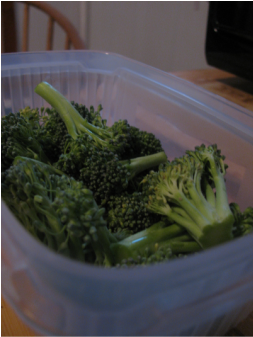
I snagged my broccoli on sale for 99 cents, but it's usually around $3.00 fresh. Broccoli needs to be kept cold in the fridge, and should be eaten four days after buying at most.
And yes, I'm going to steam my broccoli in the microwave. I might miss the flavonoids, but that's a trade-off I'm willing to take since I don't have the necessary instruments for stove-top steaming (and I'd rather conquer my fear of conventional cooking another day).
The procedure:
Buying: Check out the tops (called florets) and avoid bunches that have yellowing.
Cooking: this whole process takes about 5 minutes, depending on how quickly you chop.
1. Wash your Broccoli. It's already been cleaned before it was packed, but the quality of water used to do this might not be to your standards.
2. Cut the broccoli into bite-size pieces. I'm only going to cook the tops but some people cut up the stem and eat it too.
3. Put the pieces in a microwave safe container and add a small amount of water. For the florets on one stalk, you should only need a tablespoon.
And yes, I'm going to steam my broccoli in the microwave. I might miss the flavonoids, but that's a trade-off I'm willing to take since I don't have the necessary instruments for stove-top steaming (and I'd rather conquer my fear of conventional cooking another day).
The procedure:
Buying: Check out the tops (called florets) and avoid bunches that have yellowing.
Cooking: this whole process takes about 5 minutes, depending on how quickly you chop.
1. Wash your Broccoli. It's already been cleaned before it was packed, but the quality of water used to do this might not be to your standards.
2. Cut the broccoli into bite-size pieces. I'm only going to cook the tops but some people cut up the stem and eat it too.
3. Put the pieces in a microwave safe container and add a small amount of water. For the florets on one stalk, you should only need a tablespoon.
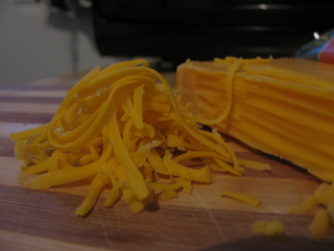
Steaming is great because it uses so little water, but it's come to my attention that there are concerns about cooking in plastic containers.. The fix: glass dishes.
4. Cover the container (I just set the cover loosely on top) and cook on high for 2 minutes.
When it's done, I like to put a little cheddar cheese on top. Salt and pepper works too, but a bit of fat helps with nutrient digestion.
Know your plants:
Canadian broccoli is grown, for the most part, in Quebec, Ontario and British Columbia, but only about 30% of the broccoli we consume is domestic. The rest, like my squash, comes from California. This is a bit odd considering that this super food does well in cooler climates, but California can produce broccoli year round with cheap labour. This makes production a risky idea for Canadian producers who already feel pressure to turn out higher yields out of less and less farm land.
4. Cover the container (I just set the cover loosely on top) and cook on high for 2 minutes.
When it's done, I like to put a little cheddar cheese on top. Salt and pepper works too, but a bit of fat helps with nutrient digestion.
Know your plants:
Canadian broccoli is grown, for the most part, in Quebec, Ontario and British Columbia, but only about 30% of the broccoli we consume is domestic. The rest, like my squash, comes from California. This is a bit odd considering that this super food does well in cooler climates, but California can produce broccoli year round with cheap labour. This makes production a risky idea for Canadian producers who already feel pressure to turn out higher yields out of less and less farm land.
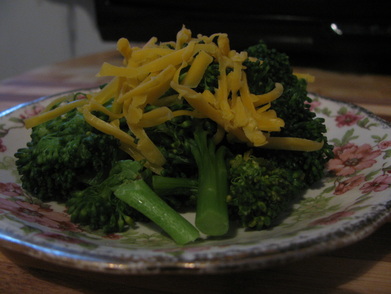
Growing broccoli is fairly labour intensive. Seeds aren't usually planted directly into the field so the fledgling broccoli has to be transplanted. This happens after the soil has been tested for the proper nutrients, and fertilizers are laid to compensate for any that might be missing. We don't often think about it, but the nutrients in our food are only as good as the nutrients in our soil.
Between June and October most varieties of broccoli are ready to be harvested. As my brothers will tell you, broccoli is harvested by hand. It's washed, bunched (they learned the alphabet backwards while doing this) and packaged into wax boxes with slushy ice to keep the stalks cold. It's important to cool the broccoli soon after it's removed from the sun to preserve firmness and prevent yellowing
Most broccoli historians say New York's Italian immigrants are to thank for this plant's place in North American cuisine. The ancient Greeks enjoyed a floret or two, and broccoli has been grown in France and Italy since the 1500s. Overall, broccoli has been known for about 2000 years, making it a seriously primeval plant.
Flavonoids or no flavonoids, I'm happy to have this five-minute super food as part of my culinary arsenal. Maybe instant mashed potatoes are too convenient to be true, but microwave-steamed broccoli hits the mostly plants mark perfectly.
Thanks for reading, and check back March 2nd for succulent soy-bean edamame.
Between June and October most varieties of broccoli are ready to be harvested. As my brothers will tell you, broccoli is harvested by hand. It's washed, bunched (they learned the alphabet backwards while doing this) and packaged into wax boxes with slushy ice to keep the stalks cold. It's important to cool the broccoli soon after it's removed from the sun to preserve firmness and prevent yellowing
Most broccoli historians say New York's Italian immigrants are to thank for this plant's place in North American cuisine. The ancient Greeks enjoyed a floret or two, and broccoli has been grown in France and Italy since the 1500s. Overall, broccoli has been known for about 2000 years, making it a seriously primeval plant.
Flavonoids or no flavonoids, I'm happy to have this five-minute super food as part of my culinary arsenal. Maybe instant mashed potatoes are too convenient to be true, but microwave-steamed broccoli hits the mostly plants mark perfectly.
Thanks for reading, and check back March 2nd for succulent soy-bean edamame.
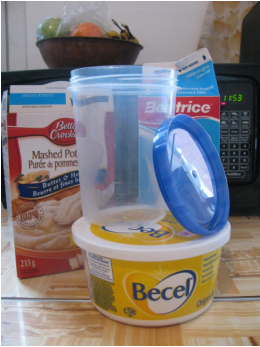
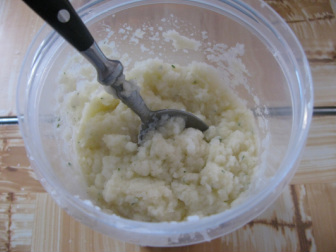
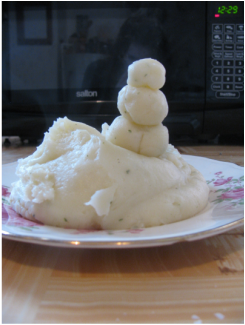
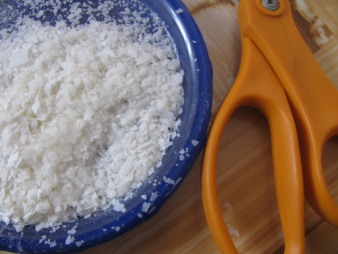
 RSS Feed
RSS Feed